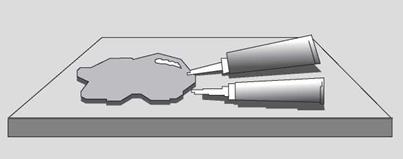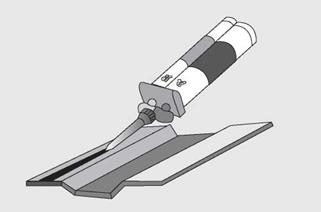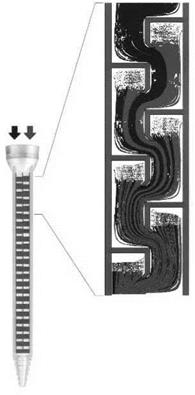Epoxies are thermoset products normally prepared by mixing a resin and a hardener or curing agent. The mixing can be achieved by mixing the correct quantities by hand on a small pallet (Figure 1.23) or (more usually for production applications) by dispensing directly from the original containers via a helix nozzle (Figure 1.24).
Precise measuring of the resin and hardener is essential to ensure the epoxy reaction is completed and thus the correct properties of the final adhesive are achieved. This critical mix ratio is perhaps a disadvantage of epoxies over other two-part adhesive systems. The helix nozzle ensures good mixing, provided there are sufficient mixing segments in the nozzle (Figure 1.25).
|
Figure 1.23 Mixing epoxy on a pallet |
|
|
|
Figure 1.25 An epoxy nozzle |
Epoxies exotherm during the cure process and so when a large amount of mixed epoxy is dispensed onto a component part, the temperature will increase thus accelerating the cure time. Correspondingly if only small quantities of epoxy are dispensed, the cure speed may well be longer than quoted on the data sheet as there is insufficient mass of adhesive present to help drive the cure along. Epoxies can be heat cured and as a good rule of thumb the cure time will be halved for every 10 °C rise in temperature.
Single-part epoxies are available (where the resin and hardener are pre-mixed) but these usually require refrigerated storage and a heat cure.
Epoxies are extremely versatile adhesives due to the large number of combinations of epoxy resins and hardeners that are available, each of which can give a different molecular structure in the resulting cured polymer [3]. Additives include fillers, rubber tougheners, plasticisers and other modifiers to customise adhesives for specific applications. A range of electrically conductive (silver-filled) epoxies are available and these are becoming popular in electronics bonding and sealing applications. An electrically conductive adhesive will never have the same performance in terms of conductivity or durability as a soldered joint (where a true inter-metallic layer is achieved) but they can offer high resistance to humidity and continuous service temperatures up to 140 °C [4].
Epoxies generally have excellent adhesion to metals, ceramics and glass, although on most amorphous thermoplastics epoxies will usually be outperformed by MMA, UV adhesives or cyanoacrylates. Epoxies will bond well to thermoset plastics and are widely used for bonding sheet moulding compound door and body panels in the transportation industries. Epoxies do not adhere well to elastomers, fluoropolymers or polyolefin plastics.
They will fill very large gaps and have excellent thermal and environmental resistance and so are widely used for the potting and encapsulation of electronic components and printed circuit boards.
Epoxies can be modified with various additives, fillers, plasticisers, rubber tougheners and other polymers and so there are a huge number of epoxy adhesives available and numerous specialist grades.
 8 сентября, 2015
8 сентября, 2015  Pokraskin
Pokraskin 


 Опубликовано в рубрике
Опубликовано в рубрике 